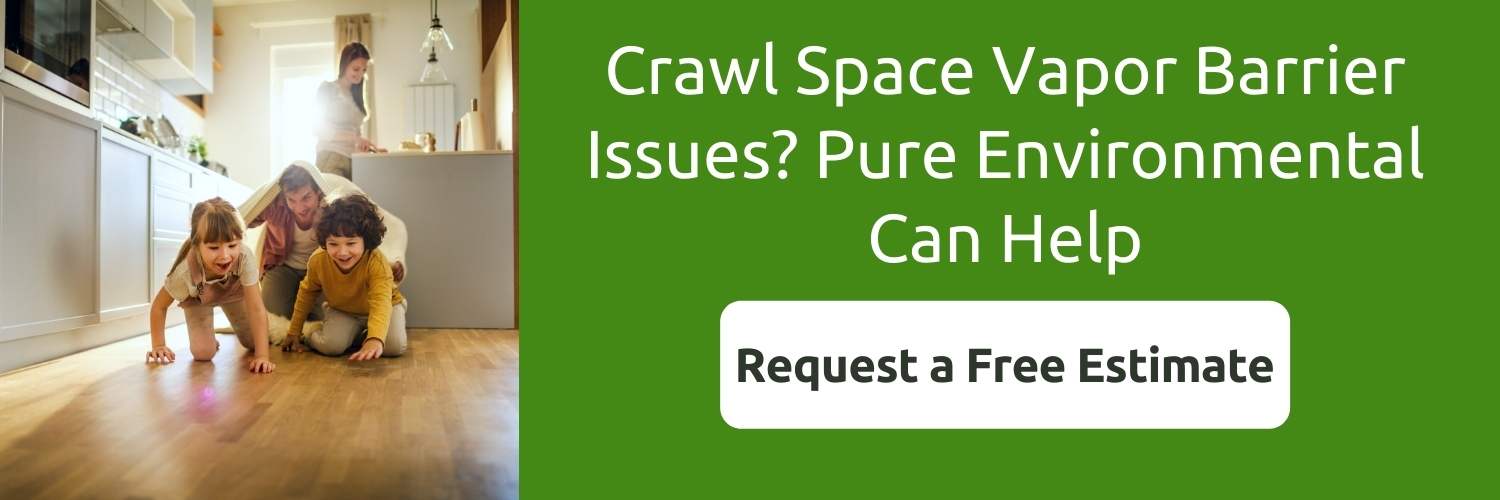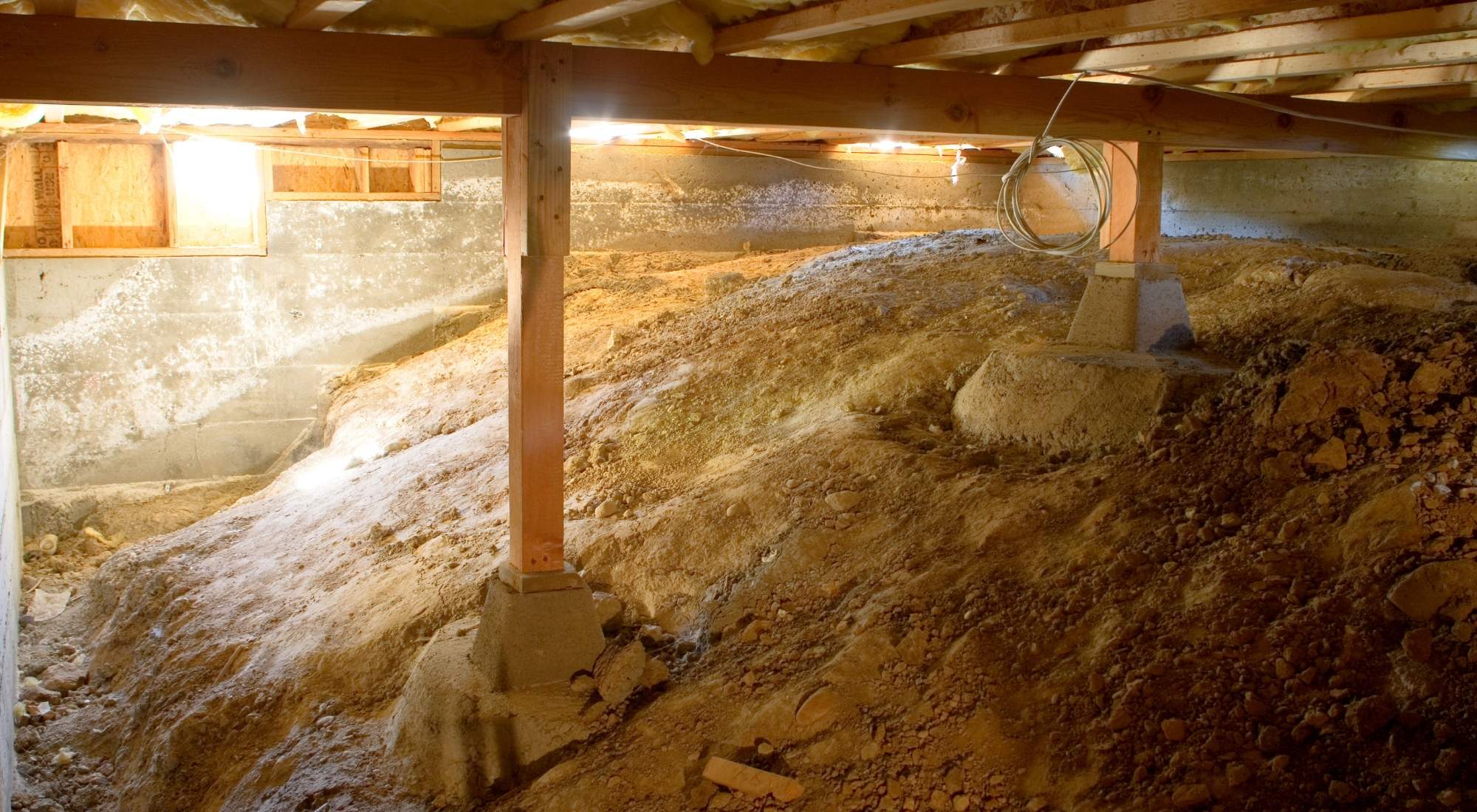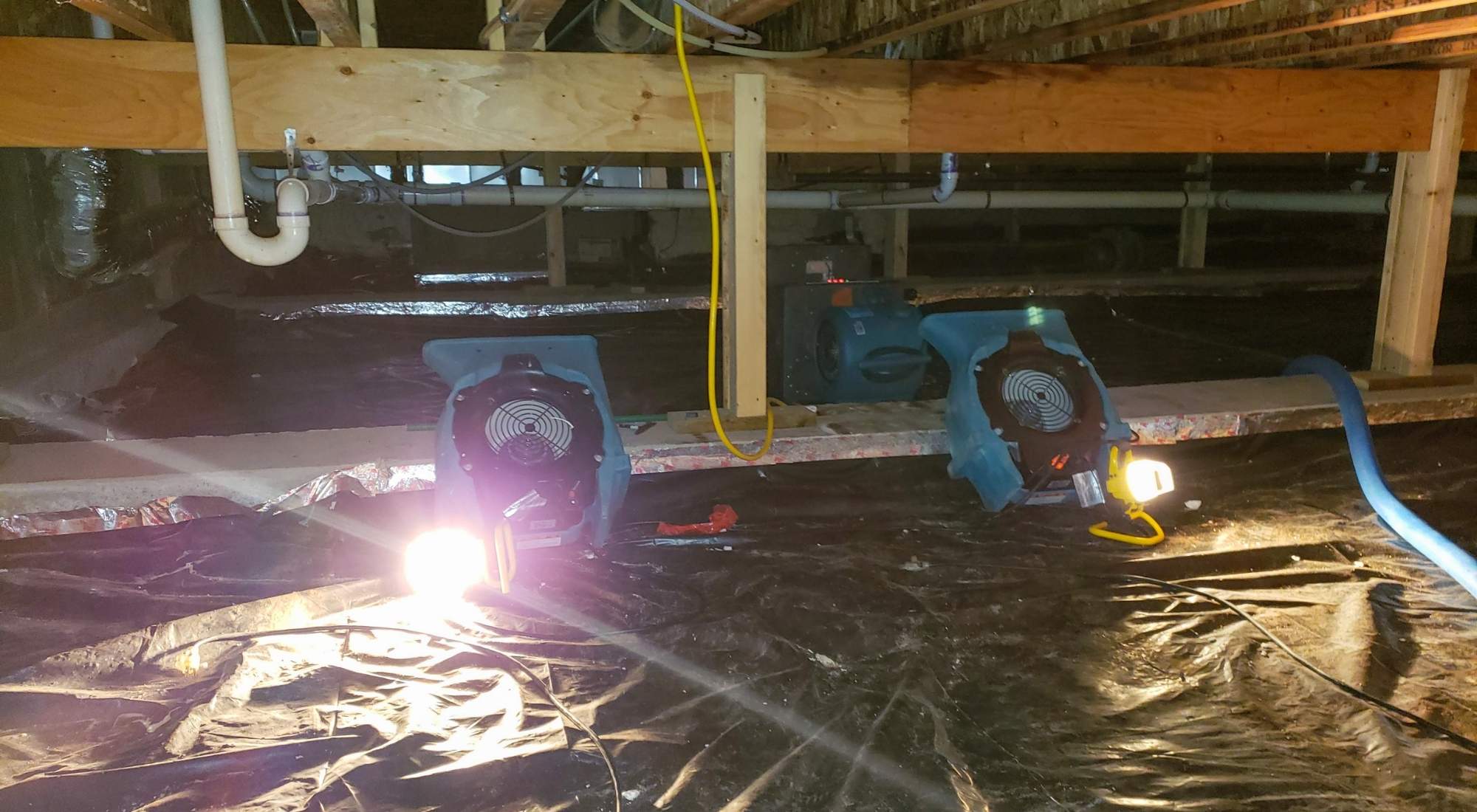Standing water, wood rot, mold — finding these issues in your crawl space is enough to make your stomach drop. You can almost hear the sound of money leaving your bank account.
If you want to avoid these issues, you need a vapor barrier installed in your crawl space. No ifs, ands, or buts.
In this guide, we will discuss factors and benefits that make vapor barriers a must-have for your crawl space.
Table of Contents
- What Is a Vapor Barrier?
- Do I Need a Vapor Barrier in My Crawl Space?
- Moisture: Your Crawl Space’s Number One Enemy — How Does It Find Its Way Into Your Crawl Space?
- Combatting Moisture: 6 Benefits of a Crawl Space Vapor Barrier
- Installing a Vapor Barrier in Your Crawl Space
- Crawl Space Vapor Barrier Maintenance
- Pure Environmental Can Assist With Managing Vapor Barrier-Related Issues in Your Crawl Space

What Is a Vapor Barrier?
A vapor barrier is a thick sheet of polyethylene plastic that is used to cover the flooring of your crawlspace to prevent exposure to water vapor. This simple sheet of plastic can save you a lot of heartache and costs that come with mold issues and structural damage to your home caused by water damage.
Do I Need a Vapor Barrier in My Crawl Space?
The short answer is yes — a resounding yes.
There is really no reason NOT to have a vapor barrier in your crawl space. Some installers will tell you that you only need a vapor barrier in your crawl space if the “floor” of your crawl space is dirt, but the truth is that installing a vapor barrier is a fundamental component in keeping your crawl space dry.
Your crawl space is dark, musty, and cold — making it the perfect host for moisture, mold, and mildew. A vapor barrier can help prevent moisture from seeping through the floor of your crawl space, which can cause a slew of problems (more on this later!).

Moisture: Your Crawl Space’s Number One Enemy — How Does It Find Its Way Into Your Crawl Space?
When many people think of water damage, an image of a leaky pipe comes to mind. However, there is more than one way to crack an egg.
Oftentimes, moisture can seep through the dirt floor of your crawl space when you do not have a vapor barrier installed. Additionally, poor grading and improper vapor barrier installation can lead to rainwater leaking into your crawlspace, causing a huge standing water issue.
You may be thinking, there’s a layer of insulation and flooring between your home and the crawl space, why should you care if your crawl space gets a little wet?
All of the materials that may exist above your crawl space — concrete, wood, even fiberglass insulation — are porous materials. This means that water vapors can easily pass through these materials, which can cause devastation to the structure of your home.
Preventing water vapor from penetrating your crawl space by installing a water vapor barrier is your first line of defense against water damage.

Combatting Moisture: 6 Benefits of a Crawl Space Vapor Barrier
If you’re not yet convinced why a vapor barrier in your crawl space is a must, these six benefits may do the trick.
#1: A Vapor Barrier Discourages Mold Growth
Moisture. Mildew. Mold. There is the truth behind the old adage — bad things come in threes.
If you notice any standing water in your crawl space, chances are that you have mold growth and need to contact a mold remediation company as soon as possible.
Installing a vapor barrier helps keep your crawl space nice and dry, so you don’t have to worry about whether you have colonies of mold camping out in your crawl space.
#2: A Vapor Barrier Can Prevent Musty Odors
Cold, damp, moldy environments create an unmistakable musty odor. Chances are, you don’t visit your crawl frequently. So these odors can become very strong if left unattended to.
Usually the odor is contained in your crawl space. However, in rare instances, the odor might become noticeable even outside your crawl space.
A vapor barrier will protect the environment of your crawl space from becoming damp or moldy, eliminating the source of potential musty odors.
#3: It Can Prevent Poor Air Quality From Circulating Throughout the Rest of Your Home
Musty odors aren’t the only thing that can be pulled into your HVAC unit. If your crawl space has a musty odor, it probably also has mold and mildew spores. Mold particles can be pulled into your HVAC system and circulated throughout your home, making air quality a serious concern.
Poor air quality can especially be an issue if someone in your home has a respiratory condition, such as asthma.
A vapor barrier will prevent mold from growing in your crawl space and finding its way into your HVAC system.
#4: A Vapor Barrier Can Prevent Rusting
When moisture is introduced to exposed plumbing in your crawl space, you can end up with rusty, damaged pipes that can lead to deterioration and failure over time — along with hefty costs in damages.
Installing a vapor barrier is far less expensive than dealing with severe water damage from a plumbing leak. A vapor barrier will eliminate the conditions in which this type of damage can be prone to occur by leaving your crawl space nice and dry.
#5: A Vapor Barrier Can Reduce the Chances of Wood Rot
Wood that is exposed to water vapor will ultimately begin to rot. This process can be aided by fiberglass insulation, which can retain moisture and transfer it to the surrounding structure.
Wood rot can severely damage the structural integrity of your home. As if that isn’t bad enough, soft, rotted wood also makes an excellent meal for termites, which only furthers the devastation of your home’s structure.
A vapor barrier can protect you from these structural nightmares that can drain your wallet.
#6: A Vapor Barrier Can Reduce the Risk of an Electrical Short
If there is electrical wiring in your crawl space, outside factors such as water vapor and rodents are the last thing you want sharing this space.
While you may not initially have exposed wires in your crawl space, deterioration of your insulation and wooden structure can lead to exposed electrical wiring.
Exposed wires are the perfect storm for electrical shorts, which can cause a fire.
Installing a vapor barrier can help eliminate this fire hazard and give you some extra peace of mind.

Installing a Vapor Barrier in Your Crawl Space
A trained professional can install a vapor barrier in your crawl space in a few easy steps:
- The floor of the crawl space is graded, and any loose debris is removed. This is a critical first step that many amateur installers miss. It’s important to make sure that the crawl space floor is flat and level to ensure the vapor barrier is installed properly without risks of developing air bubbles or tears in the barrier.
Note: Sometimes the topography of a crawl space makes this step difficult. In those instances, water routing and sump pumps are often the solution.
- The entire space is assessed and measured to ensure the vapor barrier is properly laid out and cut in the proper places to account for any obstacles.
- A 6-mil polyethylene vapor barrier sheet is tightly laid down on the crawl space floor to achieve as much ground cover as possible. The barrier is also installed to cover 6 inches up the walls of the entire crawl space. In accordance with the U.S. Department of Energy, any sheet seams must be covered by a 12-inch overlap and sealed with tape for proper installation.
Can You Install a Water Vapor Barrier on Your Own?
As a homeowner, you may be tempted to cut costs by purchasing a vapor barrier and installing it yourself. This is not recommended.
Water damage caused by improper water vapor installation will be far more expensive to fix than hiring a professional to install your vapor barrier correctly in the first place.

Crawl Space Vapor Barrier Maintenance
A properly installed vapor barrier should hold up for years without the need for maintenance.
However, it’s important to inspect your vapor barrier for damages at least on a yearly basis, especially during dry weather. This safety measure can help you spot any potential issues before they become more severe.
Inspecting your vapor barrier is easy. Simply use a flashlight to look around and make sure there are no tears in your barrier. If you spot any tears, you’ll want to schedule repairs as soon as possible.
While you’re inspecting your vapor barrier, it’s a good idea to take a look at your subflooring and make sure there are no signs of rot as well.
Pure Environmental Can Assist With Managing Vapor Barrier-Related Issues in Your Crawl Space
Have you noticed a funky smell coming from your crawl space? Or perhaps you have found standing water or evidence of rot and mold?
Oftentimes, water vapor damage in crawl spaces isn’t noticed until damage has already begun to set in.
If you are located in the Oregon or Washington, area, give us a call. We serve clients in many cities across each state.
Our team of professionals is licensed and insured and highly trained in odor removal and mold remediation. We can help restore your crawl space back to an ideal environment by installing or repairing a vapor barrier.
If you’re experiencing vapor barrier-related issues, don’t delay. The sooner we can begin treating your crawlspace, the sooner we can stifle damages before they become more severe.
Recent posts
- Pros and Cons of Heat Treatment for Bed Bugs: Things To Consider When Reviewing Your Options for Remediation
- How To Get Rid of Pet Odor in Your House
- Clearing the Air: How To Clean Walls From Cigarette Smoke
- Deodorizing Your Living Space: How To Get Rid of a Musty Smell in Your House
- How Do You Get Rid of Mold in Your Attic? Tips from the Professionals
Recent Posts
- Pros and Cons of Heat Treatment for Bed Bugs: Things To Consider When Reviewing Your Options for Remediation
- How To Get Rid of Pet Odor in Your House
- Clearing the Air: How To Clean Walls From Cigarette Smoke
- Deodorizing Your Living Space: How To Get Rid of a Musty Smell in Your House
- How Do You Get Rid of Mold in Your Attic? Tips from the Professionals